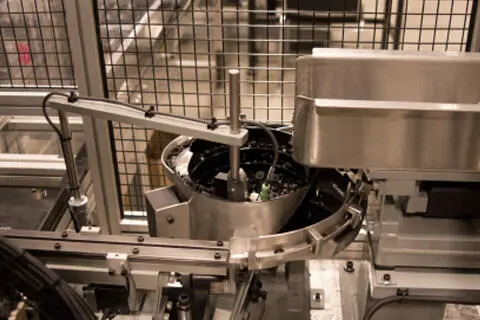
Industrial Automation Standards

Industrial automation standards are to industrial automation what industrial automation is to everything else – they make it all work smoothly and efficiently. With standards developed by ISO, IEC, and ISA, the sum total of standardization efforts in the field is immense. Providing specifications for everything from the foundational network communications profiles all the way through to the tools physically interacting with the products, standards guide the industry, promoting interoperability between vendors and devices, in turn contributing to reliability and efficiency, effectively bringing down costs.
IEC 60654-1 Ed. 2.0 b:1993
Industrial-process measurement and control equipment - Operating conditions - Part 1: Climatic conditions
See the rest of the IEC 60654 series, dealing with industrial-process measurement and control – operating conditions.

IEC 60770-1 Ed. 2.0 b:2010
Transmitters for use in industrial-process control systems - Part 1: Methods for performance evaluation
See the rest of the IEC 60770 series, dealing with transmitters for use in industrial-process control systems.
IEC 61069-1 Ed. 2.0 b:2016
Industrial-process measurement, control and automation - Evaluation of system properties for the purpose of system assessment - Part 1: Terminology and basic concepts
IEC 61069-1:2016 defines the terminology and outlines basic concepts in the assessment of a basic process control system (BPCS) and a basic discrete control system (BDCS). These two general system types cover the areas of discrete, batch and continuous applications. In IEC 61069 these two, BPCS and BDCS, together are referred to as "basic control system(s)", (BCS). This second edition cancels and replaces the first edition published in 1991. This edition constitutes a technical revision. This edition includes the following significant technical changes with respect to the previous edition: - Reorganization of the material of IEC 61069-1:1991 to make the overall set of standards more organized and consistent; - IEC TS 62603-1:2014 has been incorporated into this edition.
IEC 61158-1 Ed. 2.0 en:2019
Industrial communication networks - Fieldbus specifications - Part 1: Overview and guidance for the IEC 61158 and IEC 61784 series
IEC 61158-1:2019 (E) specifies the generic concept of fieldbuses. This document presents an overview and guidance for the IEC 61158 series explaining the structure and content of the IEC 61158 series, relating the structure of the IEC 61158 series to the ISO/IEC 7498-1 OSI Basic Reference Model and showing how to use parts of the IEC 61158 series in combination with the IEC 61784 series. It also provides explanations of some aspects of the IEC 61158 series that are common to the type specific parts of the IEC 61158 5 including the application layer service description concepts and the generic fieldbus data types. This second edition cancels and replaces the first edition published in 2014. This edition constitutes a technical revision. This edition includes the following significant changes with respect to the previous edition: • updates of the references to and information about the IEC 61158 series, IEC 61784 1, IEC 61784 3, IEC 61784-5 series and IEC 61918 throughout the document; • new Type 25 and the related profile family CPF 20; • new Type 26 and the related profile family CPF 21.

IEC 61298-1 Ed. 2.0 b:2008
Process measurement and control devices - General methods and procedures for evaluating performance - Part 1: General considerations
See the rest of the IEC 61298 series, dealing with process measurement and control devices – general methods and procedures for evaluating performance.
IEC 61508-1 Ed. 2.0 b:2010
Functional safety of electrical/electronic/programmable electronic safety-related systems - Part 1: General requirements
See the rest of the IEC 61508 series, dealing with functional safety of electrical/electronic/programmable electronic safety-related systems.
IEC 61784-1 Ed. 5.0 en:2019
Industrial communication networks - Profiles Part 1: Fieldbus profiles
IEC 61784-1:2019 (E) defines a set of protocol specific communication profiles based primarily on the IEC 61158 series, to be used in the design of devices involved in communications in factory manufacturing and process control. This fifth edition cancels and replaces the fourth edition published in 2014 it constitutes a technical revision. The main changes are: • update of the dated references to the IEC 61158 series, to IEC 61784 2, to the IEC 61784 3 series, to the IEC 61784-5 series and to IEC 61918 throughout the document; • update of selection tables CPF 2, CPF 4 and CPF 8

IEC 61987-1 Ed. 1.0 b:2006
Industrial-process measurement and control - Data structures and elements in process equipment catalogues - Part 1: Measuring equipment with analogue and digital output
See the rest of the IEC 61987 series, dealing with industrial-process measurement and control – data structures and elements in process equipment catalogues.
IEC 62264-1 Ed. 2.0 b:2013
Enterprise-control system integration - Part 1: Models and terminology
See the rest of the IEC 62264 series, enterprise-control system integration, as well as adoptions by multiple national standards bodies.
IEC 62381 Ed. 2.0 b:2012
"Automation systems in the process industry - Factory acceptance test (FAT), site acceptance test (SAT), and site integration test (SIT)"
"IEC 62381:2012 defines the procedures and specifications for the Factory Acceptance Test (FAT), the Site Acceptance Test (SAT), and the Site Integration Test (SIT). These tests are carried out to prove that the automation system is in accordance with the specification. The description of activities given in this standard can be taken as a guideline and adapted to the specific requirements of the process, plant or equipment. This second edition cancels and replaces the first edition published in 2006. This edition constitutes a technical revision. The main changes with respect to the previous edition are: The definition of the documents mentioned in this standard is in accordance with future IEC 62708."
IEC 62453-1 Ed. 2.0 b:2016
Field device tool (FDT) interface specification - Part 1: Overview and guidance
IEC 62453-1:2016 presents an overview and guidance for the IEC 62453 series. It - explains the structure and content of the IEC 62453 series (see Clause 5); - provides explanations of some aspects of the IEC 62453 series that are common to many of the parts of the series; - describes the relationship to some other standards. This second edition cancels and replaces the first edition published in 2009. This edition constitutes a technical revision. This edition includes the following significant technical changes with respect to the previous edition: introduction of a new implementation technology (defined in IEC 62453-42).
ISO 10303-1:2021
Industrial automation systems and integration - Product data representation and exchange - Part 1: Overview and fundamental principles
This document provides an overview of ISO 10303 . ISO 10303 provides a representation of product information along with the necessary mechanisms and definitions to enable product data to be exchanged. The exchange is among different computer systems and environments associated with the complete product lifecycle, including product design, manufacture, use, maintenance, and final disposition of the product. This document defines the basic principles of product information representation and exchange used in ISO 10303 . It specifies the characteristics of the various series of parts of ISO 10303 and the relationships among them. The following are within the scope of this document: scope statement for ISO 10303 as a whole; overview of ISO 10303 ; architectures of ISO 10303 ; structure of ISO 10303 ; terms and definitions used throughout ISO 10303 ; overview of data specification methods used in ISO 10303 ; NOTE This includes the EXPRESS data specification language and graphical presentation of product information models. introduction to the series of parts of ISO 10303 : integrated resources; application interpreted constructs; application modules; business object models; application protocols; implementation methods; usage guides; conformance testing methodology and framework; abstract test suites; scheme for identification of schemas and other information objects defined within parts of ISO 10303 .
ISO 23570-1:2005
Industrial automation systems and integration - Distributed installation in industrial applications - Part 1: Sensors and actuators
See the rest of the ISO 23570 series, dealing with industrial automation systems and integration – distributed installation in industrial applications.

ISO 16100-1:2009
Industrial automation systems and integration - Manufacturing software capability profiling for interoperability - Part 1: Framework
See the rest of the ISO 16100 series, dealing with industrial automation systems and integration – manufacturing software capability profiling for interoperability.
ISO 20242-1:2005
Industrial automation systems and integration - Service interface for testing applications - Part 1: Overview
See the rest of the ISO 20242 series, dealing with industrial automation systems and integration – service interface for testing applications.

ISO 15531-1:2004
Industrial automation systems and integration - Industrial manufacturing management data - Part 1: General overview
See the rest of the ISO 15531 series, dealing with industrial automation systems and integration – industrial manufacturing management data.

ISO 13584-1:2001
Industrial automation systems and integration -- Parts library -- Part 1: Overview and fundamental principles
See the rest of the ISO 13584 series, dealing with industrial automation systems and integration – parts library, as well as adoptions by multiple national standards bodies.

ANSI/ISA 5.06.01-2007
Functional Requirements Documentation for Control Software Applications
Covers real-time batch, discrete and continuous process automation systems. Defines regulatory, event-driven and time-driven control system actions. Encompasses both digital and analog control devices in addition to non-control actions (for example, operator messages and batch end reports). Encompasses both normal and abnormal operational requirements of systems and shows the interactions between them. Uses a set of terms that relate directly to the languages commonly used by plant operators. Excludes interactions with higher-level systems. Within the parameters of this scope, the standard is intended to: Establish functional requirements specifications for control software documentation that covers the classes of industrial automation equipment and systems consisting of distributed control systems, programmable controllers and industrial personal computers (see Figure 1). Provide techniques for documenting control system software. The software to be generated is a function of the computer system chosen for a particular project. The documentation procedure set forth in this standard is independent of the hardware/software system that is chosen. Provide a basis for validation of run-time application software after it is developed and tested to ensure that the initial requirement specification has been met. The documentation resulting from use of this standard: Can be used for control software definition, design, testing and validation. Is not intended to require specialized knowledge of any particular engineering or computer science discipline to develop or understand.
ISA TR100.00.03-2011
Wireless Use Requirements for Factory Automation
This technical report presents descriptive user and market-related requirements of wireless communication in factory automation applications. It provides references to all six ISA100 usage classes; use case descriptions and comparisons; descriptions of factory automation topologies; and recommendations for attributes and values for existing, emerging, and conceptual solutions for wireless communications as applied to factory automation applications.
ISA TR100.14.01-2011
Trustworthiness in Wireless Industrial Automation: Part 1, Information for End Users and Regulators
This Part 1 Technical Report, in combination with the forthcoming Part 2, discusses trustworthiness associated with the use of wireless technology in industrial automation systems. Specifically excluded are those attributes that may be in common with wired systems and are therefore covered elsewhere, or attributes that are specific to other application domains such as healthcare applications. Also excluded are those attributes associated with ancillary issues such as health effects of RF or component materials (such as batteries). For this document, trustworthiness encompasses attributes associated with reliability, security and resiliency.
ANSI/ISA TR100.15.01-2012
Backhaul Architecture Model: Secured Connectivity over Untrusted or Trusted Networks
This document presents an architecture model for interconnecting automation system elements over untrusted backhaul networks. The focus is on wireless physical la yer but is not limited to wireless.
